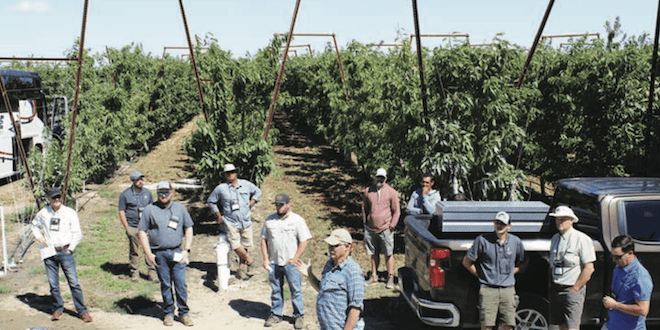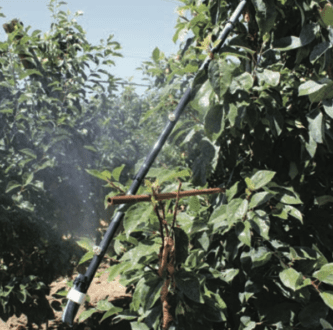

Aug 5, 2022Grower innovations displayed in IFTA Summer Tour
At the International Fruit Tree Association’s (IFTA) 2022 Summer Tour, participants gained insights into effectively growing apples, cherries and pears.
During the July 17-20 tour, industry participants visited Columbia River Basin fruit growers who told them how they’re more efficiently growing tree fruit, including using netting to protect from sunburn and promote
even coloring.
At a Premier Honeycrisp orchard at McDougall & Sons Inc., east of Wenatchee, participants learned the benefits and drawbacks of orchard netting. After trying several different netting configurations, McDougall settled on a netting system that can be quickly opened and closed with less labor. He started with a netting system that required numerous aerial work platforms and deployment time.
While definitely reducing culls lost to sunburn, it required too much time and labor to retract the system and delayed fruit color considerably, often at the expense of fruit maturity, said Scott McDougall.
Most of McDougall’s trellis systems are on a 2-foot by 12-foot steep V with some recent plantings on a 2-foot by 11-foot spacing. “We have to be careful about light interception and make sure that we don’t plant so close that shading will reduce our crop in the bottom part of the tree,” he said.
Grove light
“We have been successful planting high-density cherry systems to take advantage of platform use and possible future developments with mechanical pruning and harvesting,” McDougall said. “A word of caution: make sure you are disciplined to manage and control tree height and use diameter size pruning for both renewal and light interception or you’ll be sorry.”
At Douglas Ag Services, a third-generation Pasco orchard management company, area manager Garrett Henry discussed netting and rootstocks.
“What’s interesting with the shade on apples in general is you don’t get as much high-density color on the sun side of the apple, but you do seem to get a nicer color on the fruit all the way around,” he said.
While netting isn’t a necessity for the Cosmic Crisps Douglas grows, it’s more required for some other varieties grown in the Columbia River Basin, including Raves and SweeTangoes.
Netting shade
Douglas’ highest-quality Cosmic Crisps are netted.


“We have continued to put shade over our blocks to manage sunburn where it didn’t have overhead cooling or enough water,” Henry said. “A lot of times when we have overhead cooling, we see a more intense darker red on that sun side of the fruit. But, under shade cloth, we still do run overhead cooling, but tend to run towards harvest to keep the orchard cooler in the evenings.
“You tend to get better coloring when you have a higher fluctuation between daytime and nighttime temperatures,” he said. “It tends to bring on coloring and pigment formation.”
The verdict remains out on which apple rootstocks are most productive, Henry said. Douglas is actively using the G.41, G.11 and G.935 rootstocks.
“Not that we know everything about Cosmic Crisps, but if you put them on the wrong piece of ground or get the wrong rootstock scion combo, it can punish you because it won’t fill that space very well if you don’t fertilize and train it properly,” he said. “With other rootstocks, if you’re not on your timing or don’t get it done quite right, you can still get there, but it takes longer.”
Visiting a SweeTango (the brand name for the Minneiska variety) orchard in Quincy, tour participants saw fruit being cooled through fogging, an older evaporative cooling technology that’s making a comeback. By keeping apples wet, the overhead cooling protects the fruit.
Cutting corners
Dale Goldy, a partner with Wenatchee’s Gold Crown Nursery and G2 Orchards in Cashmere, stressed how his orchards are trying to challenge the mindset of what the industry is doing with tree spacing. While the ballooning number of apple varieties is good for shoppers, the challenge is the worst fruit an orchard will ever produce comes during a variety’s first years.
Goldy wants to plant a tree that can be placed directly into production, avoiding the need for fertilization.
“How do we shorten the time to get into high-quality fruit, because we’re either not filling space and being short of production, or, we’ve fertilized like crazy to push the trees to grow, then they’re out of balance for three to four years after you stop the fertilization?” he said.


in Wenatchee, Washington, tells IFTA tour participants about his experiments in placing trees directly into production, shortening production time and avoiding the need for fertilization.
“What could we do if we took filling space out of the equation and didn’t have to fertilize too much, what could the tree spacings be,” Goldy said. “One of my intentions is to try to figure out what we could do if we grew a tree in a nursery that was essentially tall enough to fill that seven-foot space. Could we avoid these pre-productive years and shorten the time required for high-quality fruit?”
At a recently harvested cherry orchard north of Pasco, tour attendees met Denny Hayden of Hayden Farms, a second-generation sweet cherry operation. Hayden discussed how his operation grows 13 feet by eight feet cherry plantings on V-shaped trellises.
“One reason we went to deep trellises, we’re trying to automate as much functions as possible,” Hayden said. “We want to be able to set it up to where we can automate the trimming process. Labor is difficult. It’s getting tougher to get crews. The labor situation is untenable from a management standpoint.”
Growers from throughout the U.S. and across the globe participated in the tour, including Canada, Mexico, Chile and Ireland. More than 100 were registered to attend, according to the IFTA.
—Doug Ohlemeier, assistant editor














